check engine light GMC YUKON XL 2007 User Guide
[x] Cancel search | Manufacturer: GMC, Model Year: 2007, Model line: YUKON XL, Model: GMC YUKON XL 2007Pages: 608, PDF Size: 3.01 MB
Page 262 of 608

SERVICE TRACTION CONTROL
If your vehicle has StabiliTrak®, this message will
display when there is a problem with the traction
control system. When this message is displayed,
the system will not limit wheel spin. Adjust
your driving accordingly. See your GM dealer for
service. SeeStabiliTrak
®System on page 348
for more information.
STABILITRAK OFF
If your vehicle has StabiliTrak®, this message will
display when you turn off StabiliTrak®, or when
the stability control has been automatically
disabled. To limit wheel spin and realize the full
bene�ts of the stability enhancement system, you
should normally leave StabiliTrak
®on. However,
you should turn StabiliTrak®off if your vehicle gets
stuck in sand, mud, ice, or snow and you want
to rock your vehicle to attempt to free it, or if you
are driving in extreme off-road conditions and
require more wheel spin. SeeIf Your Vehicle is
Stuck in Sand, Mud, Ice, or Snow on page 388.
To turn the StabiliTrak
®system on or off, see
StabiliTrak®System on page 348.There are several conditions that can cause this
message to appear.
One condition is overheating, which could
occur if StabiliTrak®activates continuously
for an extended period of time.
The message will also be displayed if the
brake system warning light is on. See
Brake System Warning Light on page 232.
The message could be displayed if the stability
system takes longer than usual to complete its
diagnostic checks due to driving conditions.
If an engine or vehicle related problem has
been detected and the vehicle needs
service, the message will appear. See your
GM dealer.
The message will also appear if the vehicle is
shifted into 4LO.
The message will turn off as soon as the conditions
that caused the message to be displayed are no
longer present.
262
Page 263 of 608
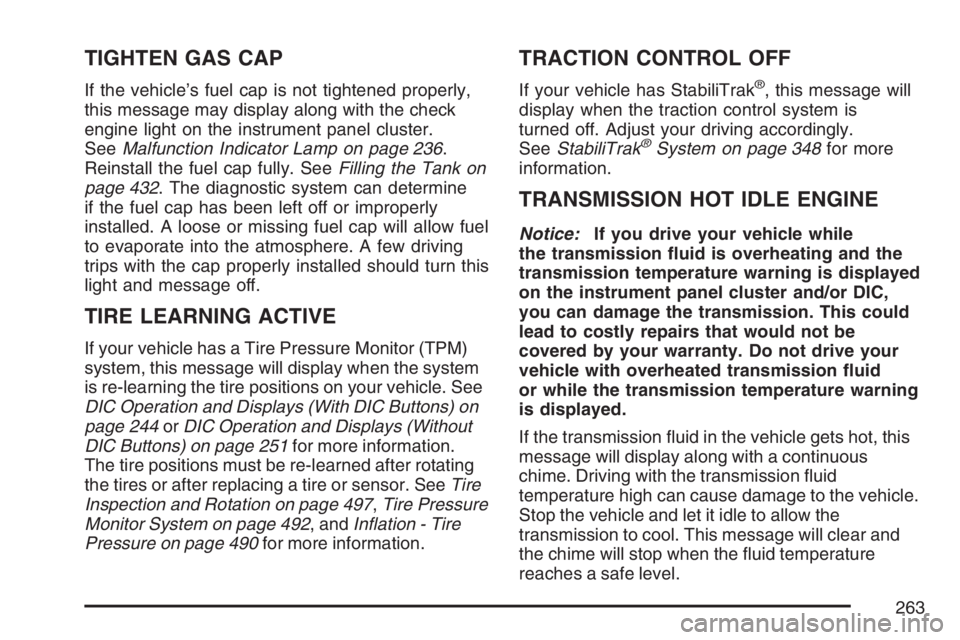
TIGHTEN GAS CAP
If the vehicle’s fuel cap is not tightened properly,
this message may display along with the check
engine light on the instrument panel cluster.
SeeMalfunction Indicator Lamp on page 236.
Reinstall the fuel cap fully. SeeFilling the Tank on
page 432. The diagnostic system can determine
if the fuel cap has been left off or improperly
installed. A loose or missing fuel cap will allow fuel
to evaporate into the atmosphere. A few driving
trips with the cap properly installed should turn this
light and message off.
TIRE LEARNING ACTIVE
If your vehicle has a Tire Pressure Monitor (TPM)
system, this message will display when the system
is re-learning the tire positions on your vehicle. See
DIC Operation and Displays (With DIC Buttons) on
page 244orDIC Operation and Displays (Without
DIC Buttons) on page 251for more information.
The tire positions must be re-learned after rotating
the tires or after replacing a tire or sensor. SeeTire
Inspection and Rotation on page 497,Tire Pressure
Monitor System on page 492, andIn�ation - Tire
Pressure on page 490for more information.
TRACTION CONTROL OFF
If your vehicle has StabiliTrak®, this message will
display when the traction control system is
turned off. Adjust your driving accordingly.
SeeStabiliTrak
®System on page 348for more
information.
TRANSMISSION HOT IDLE ENGINE
Notice:If you drive your vehicle while
the transmission �uid is overheating and the
transmission temperature warning is displayed
on the instrument panel cluster and/or DIC,
you can damage the transmission. This could
lead to costly repairs that would not be
covered by your warranty. Do not drive your
vehicle with overheated transmission �uid
or while the transmission temperature warning
is displayed.
If the transmission �uid in the vehicle gets hot, this
message will display along with a continuous
chime. Driving with the transmission �uid
temperature high can cause damage to the vehicle.
Stop the vehicle and let it idle to allow the
transmission to cool. This message will clear and
the chime will stop when the �uid temperature
reaches a safe level.
263
Page 345 of 608
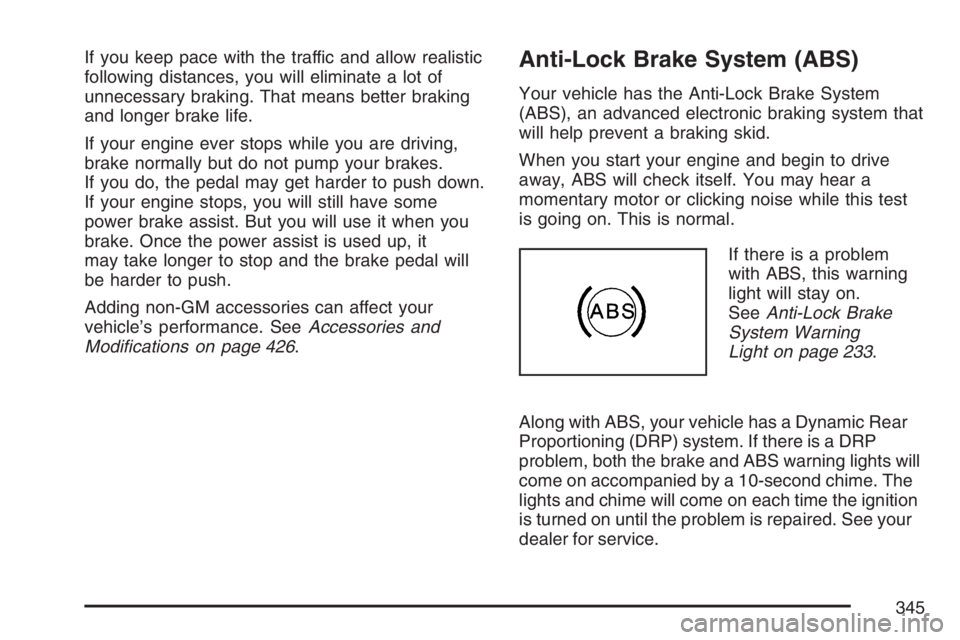
If you keep pace with the traffic and allow realistic
following distances, you will eliminate a lot of
unnecessary braking. That means better braking
and longer brake life.
If your engine ever stops while you are driving,
brake normally but do not pump your brakes.
If you do, the pedal may get harder to push down.
If your engine stops, you will still have some
power brake assist. But you will use it when you
brake. Once the power assist is used up, it
may take longer to stop and the brake pedal will
be harder to push.
Adding non-GM accessories can affect your
vehicle’s performance. SeeAccessories and
Modi�cations on page 426.Anti-Lock Brake System (ABS)
Your vehicle has the Anti-Lock Brake System
(ABS), an advanced electronic braking system that
will help prevent a braking skid.
When you start your engine and begin to drive
away, ABS will check itself. You may hear a
momentary motor or clicking noise while this test
is going on. This is normal.
If there is a problem
with ABS, this warning
light will stay on.
SeeAnti-Lock Brake
System Warning
Light on page 233.
Along with ABS, your vehicle has a Dynamic Rear
Proportioning (DRP) system. If there is a DRP
problem, both the brake and ABS warning lights will
come on accompanied by a 10-second chime. The
lights and chime will come on each time the ignition
is turned on until the problem is repaired. See your
dealer for service.
345
Page 380 of 608
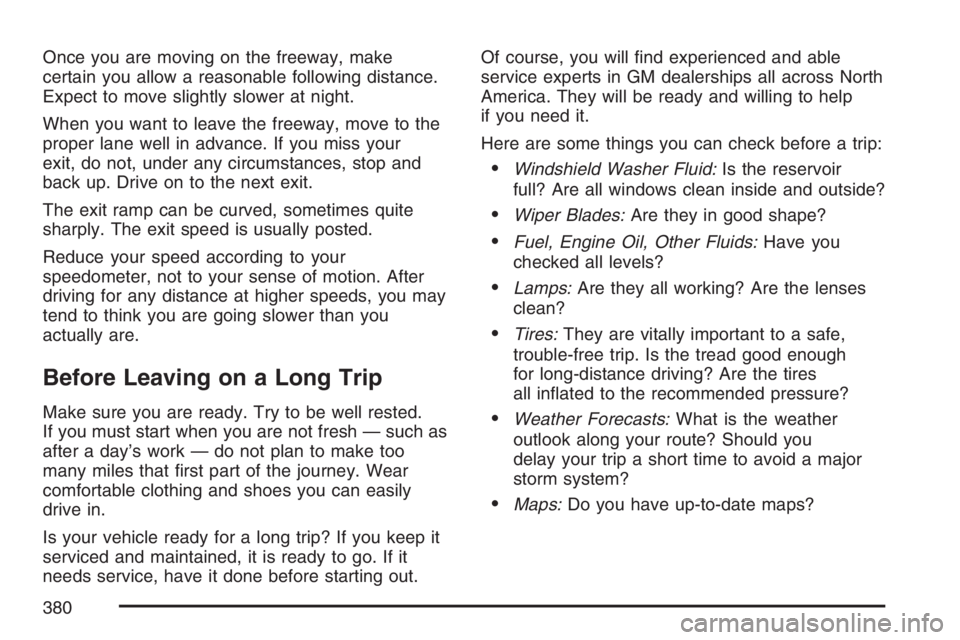
Once you are moving on the freeway, make
certain you allow a reasonable following distance.
Expect to move slightly slower at night.
When you want to leave the freeway, move to the
proper lane well in advance. If you miss your
exit, do not, under any circumstances, stop and
back up. Drive on to the next exit.
The exit ramp can be curved, sometimes quite
sharply. The exit speed is usually posted.
Reduce your speed according to your
speedometer, not to your sense of motion. After
driving for any distance at higher speeds, you may
tend to think you are going slower than you
actually are.
Before Leaving on a Long Trip
Make sure you are ready. Try to be well rested.
If you must start when you are not fresh — such as
after a day’s work — do not plan to make too
many miles that �rst part of the journey. Wear
comfortable clothing and shoes you can easily
drive in.
Is your vehicle ready for a long trip? If you keep it
serviced and maintained, it is ready to go. If it
needs service, have it done before starting out.Of course, you will �nd experienced and able
service experts in GM dealerships all across North
America. They will be ready and willing to help
if you need it.
Here are some things you can check before a trip:
Windshield Washer Fluid:Is the reservoir
full? Are all windows clean inside and outside?
Wiper Blades:Are they in good shape?
Fuel, Engine Oil, Other Fluids:Have you
checked all levels?
Lamps:Are they all working? Are the lenses
clean?
Tires:They are vitally important to a safe,
trouble-free trip. Is the tread good enough
for long-distance driving? Are the tires
all in�ated to the recommended pressure?
Weather Forecasts:What is the weather
outlook along your route? Should you
delay your trip a short time to avoid a major
storm system?
Maps:Do you have up-to-date maps?
380
Page 387 of 608
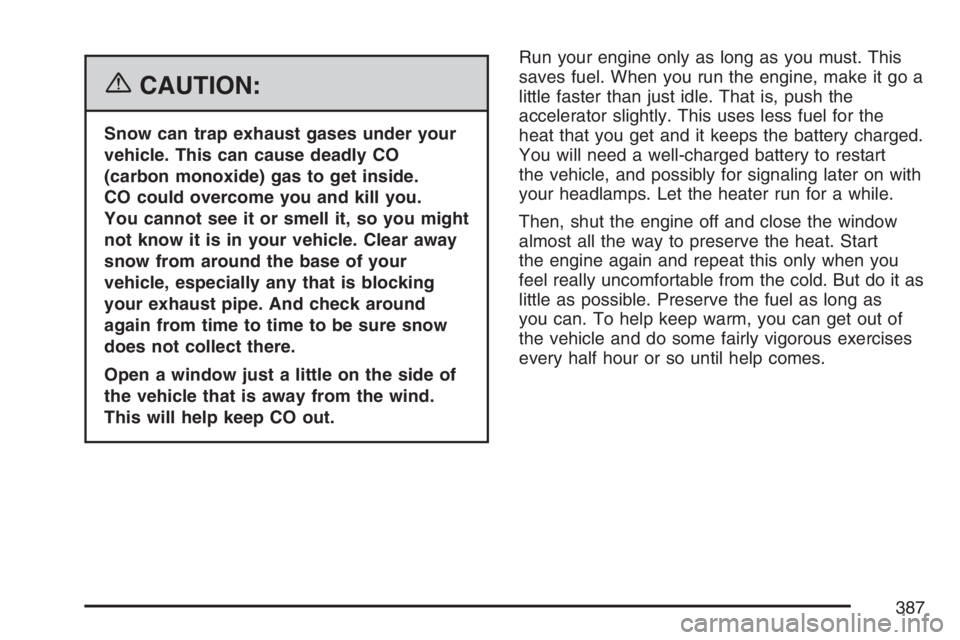
{CAUTION:
Snow can trap exhaust gases under your
vehicle. This can cause deadly CO
(carbon monoxide) gas to get inside.
CO could overcome you and kill you.
You cannot see it or smell it, so you might
not know it is in your vehicle. Clear away
snow from around the base of your
vehicle, especially any that is blocking
your exhaust pipe. And check around
again from time to time to be sure snow
does not collect there.
Open a window just a little on the side of
the vehicle that is away from the wind.
This will help keep CO out.Run your engine only as long as you must. This
saves fuel. When you run the engine, make it go a
little faster than just idle. That is, push the
accelerator slightly. This uses less fuel for the
heat that you get and it keeps the battery charged.
You will need a well-charged battery to restart
the vehicle, and possibly for signaling later on with
your headlamps. Let the heater run for a while.
Then, shut the engine off and close the window
almost all the way to preserve the heat. Start
the engine again and repeat this only when you
feel really uncomfortable from the cold. But do it as
little as possible. Preserve the fuel as long as
you can. To help keep warm, you can get out of
the vehicle and do some fairly vigorous exercises
every half hour or so until help comes.
387
Page 420 of 608
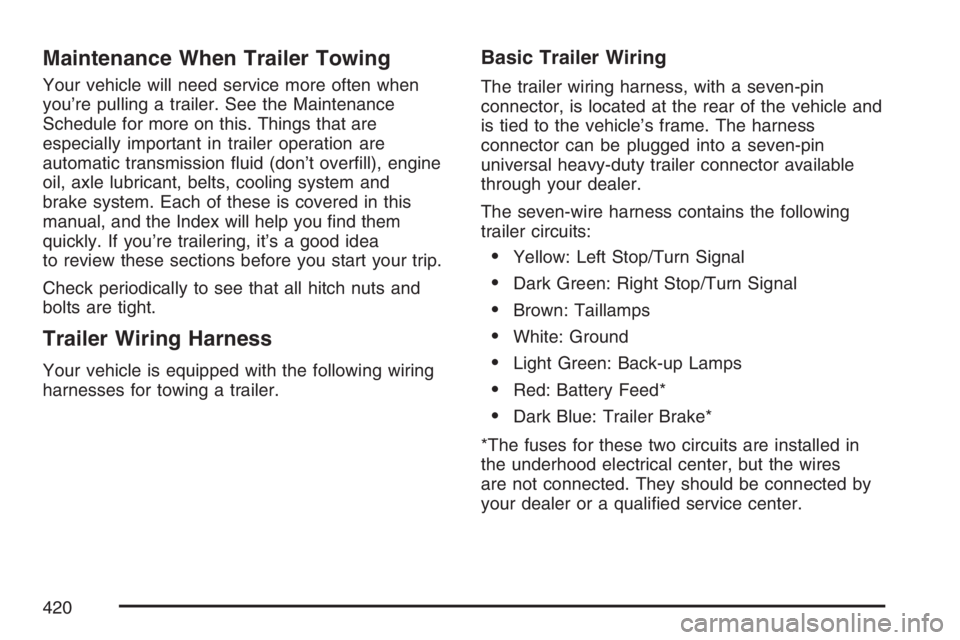
Maintenance When Trailer Towing
Your vehicle will need service more often when
you’re pulling a trailer. See the Maintenance
Schedule for more on this. Things that are
especially important in trailer operation are
automatic transmission �uid (don’t over�ll), engine
oil, axle lubricant, belts, cooling system and
brake system. Each of these is covered in this
manual, and the Index will help you �nd them
quickly. If you’re trailering, it’s a good idea
to review these sections before you start your trip.
Check periodically to see that all hitch nuts and
bolts are tight.
Trailer Wiring Harness
Your vehicle is equipped with the following wiring
harnesses for towing a trailer.
Basic Trailer Wiring
The trailer wiring harness, with a seven-pin
connector, is located at the rear of the vehicle and
is tied to the vehicle’s frame. The harness
connector can be plugged into a seven-pin
universal heavy-duty trailer connector available
through your dealer.
The seven-wire harness contains the following
trailer circuits:
Yellow: Left Stop/Turn Signal
Dark Green: Right Stop/Turn Signal
Brown: Taillamps
White: Ground
Light Green: Back-up Lamps
Red: Battery Feed*
Dark Blue: Trailer Brake*
*The fuses for these two circuits are installed in
the underhood electrical center, but the wires
are not connected. They should be connected by
your dealer or a quali�ed service center.
420
Page 463 of 608
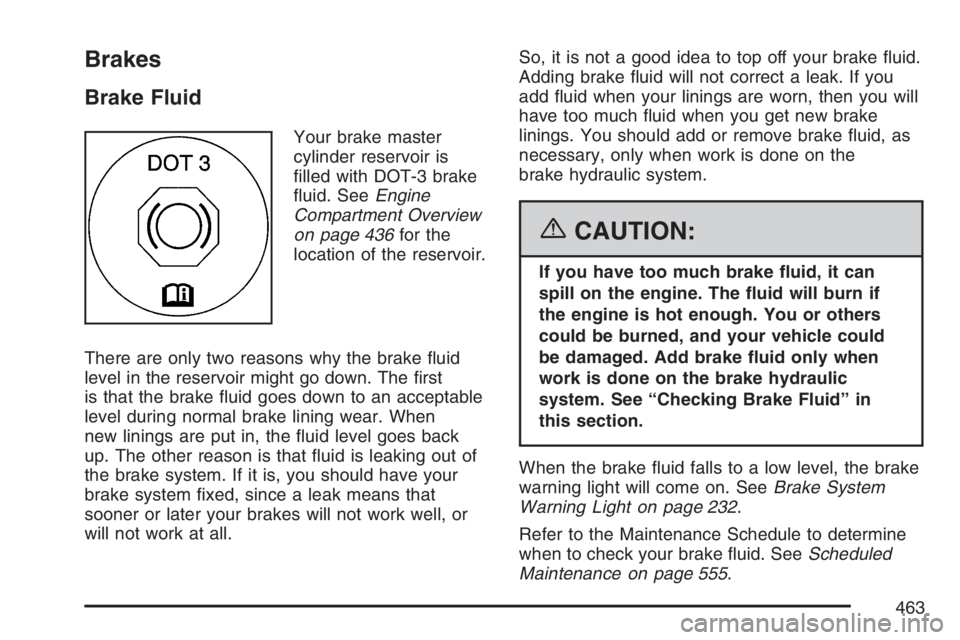
Brakes
Brake Fluid
Your brake master
cylinder reservoir is
�lled with DOT-3 brake
�uid. SeeEngine
Compartment Overview
on page 436for the
location of the reservoir.
There are only two reasons why the brake �uid
level in the reservoir might go down. The �rst
is that the brake �uid goes down to an acceptable
level during normal brake lining wear. When
new linings are put in, the �uid level goes back
up. The other reason is that �uid is leaking out of
the brake system. If it is, you should have your
brake system �xed, since a leak means that
sooner or later your brakes will not work well, or
will not work at all.So, it is not a good idea to top off your brake �uid.
Adding brake �uid will not correct a leak. If you
add �uid when your linings are worn, then you will
have too much �uid when you get new brake
linings. You should add or remove brake �uid, as
necessary, only when work is done on the
brake hydraulic system.
{CAUTION:
If you have too much brake �uid, it can
spill on the engine. The �uid will burn if
the engine is hot enough. You or others
could be burned, and your vehicle could
be damaged. Add brake �uid only when
work is done on the brake hydraulic
system. See “Checking Brake Fluid” in
this section.
When the brake �uid falls to a low level, the brake
warning light will come on. SeeBrake System
Warning Light on page 232.
Refer to the Maintenance Schedule to determine
when to check your brake �uid. SeeScheduled
Maintenance on page 555.
463
Page 469 of 608
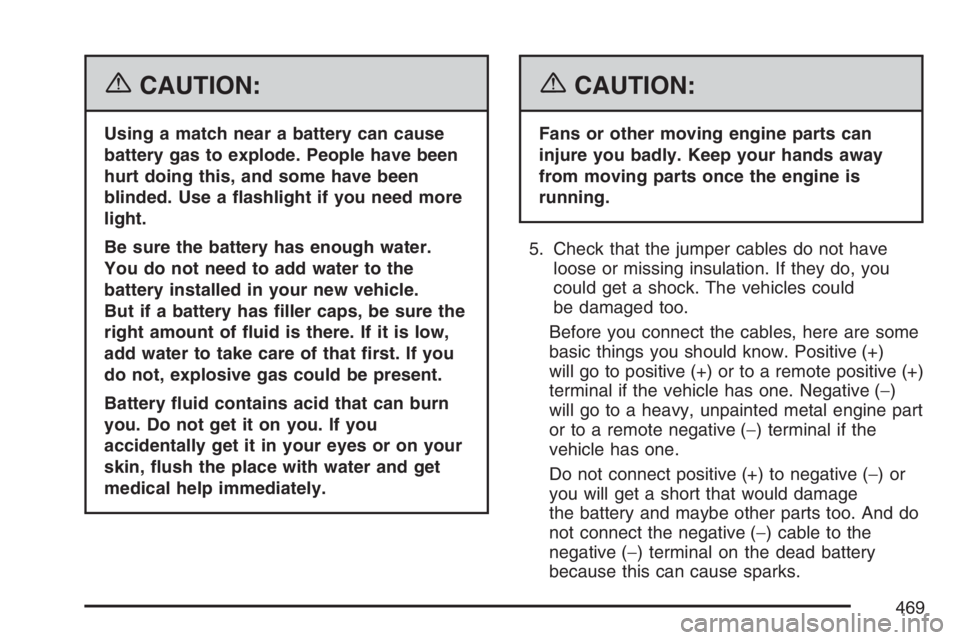
{CAUTION:
Using a match near a battery can cause
battery gas to explode. People have been
hurt doing this, and some have been
blinded. Use a �ashlight if you need more
light.
Be sure the battery has enough water.
You do not need to add water to the
battery installed in your new vehicle.
But if a battery has �ller caps, be sure the
right amount of �uid is there. If it is low,
add water to take care of that �rst. If you
do not, explosive gas could be present.
Battery �uid contains acid that can burn
you. Do not get it on you. If you
accidentally get it in your eyes or on your
skin, �ush the place with water and get
medical help immediately.
{CAUTION:
Fans or other moving engine parts can
injure you badly. Keep your hands away
from moving parts once the engine is
running.
5. Check that the jumper cables do not have
loose or missing insulation. If they do, you
could get a shock. The vehicles could
be damaged too.
Before you connect the cables, here are some
basic things you should know. Positive (+)
will go to positive (+) or to a remote positive (+)
terminal if the vehicle has one. Negative (−)
will go to a heavy, unpainted metal engine part
or to a remote negative (−) terminal if the
vehicle has one.
Do not connect positive (+) to negative (−)or
you will get a short that would damage
the battery and maybe other parts too. And do
not connect the negative (−) cable to the
negative (−) terminal on the dead battery
because this can cause sparks.
469
Page 595 of 608
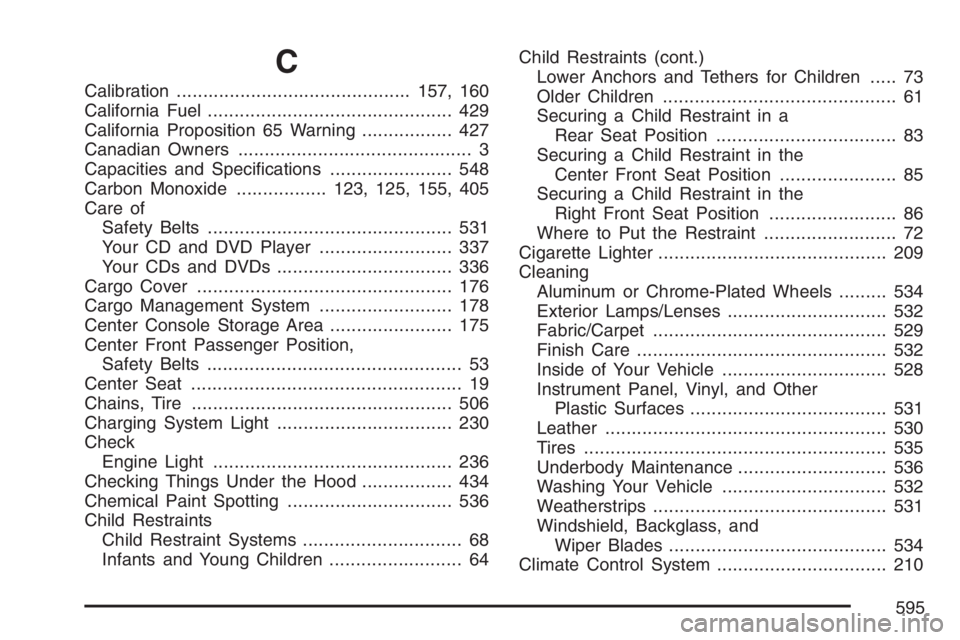
C
Calibration............................................157, 160
California Fuel.............................................. 429
California Proposition 65 Warning................. 427
Canadian Owners............................................ 3
Capacities and Speci�cations....................... 548
Carbon Monoxide.................123, 125, 155, 405
Care of
Safety Belts.............................................. 531
Your CD and DVD Player......................... 337
Your CDs and DVDs................................. 336
Cargo Cover................................................ 176
Cargo Management System......................... 178
Center Console Storage Area....................... 175
Center Front Passenger Position,
Safety Belts................................................ 53
Center Seat................................................... 19
Chains, Tire................................................. 506
Charging System Light................................. 230
Check
Engine Light............................................. 236
Checking Things Under the Hood................. 434
Chemical Paint Spotting............................... 536
Child Restraints
Child Restraint Systems.............................. 68
Infants and Young Children......................... 64Child Restraints (cont.)
Lower Anchors and Tethers for Children..... 73
Older Children............................................ 61
Securing a Child Restraint in a
Rear Seat Position.................................. 83
Securing a Child Restraint in the
Center Front Seat Position...................... 85
Securing a Child Restraint in the
Right Front Seat Position........................ 86
Where to Put the Restraint......................... 72
Cigarette Lighter........................................... 209
Cleaning
Aluminum or Chrome-Plated Wheels......... 534
Exterior Lamps/Lenses.............................. 532
Fabric/Carpet............................................ 529
Finish Care............................................... 532
Inside of Your Vehicle............................... 528
Instrument Panel, Vinyl, and Other
Plastic Surfaces..................................... 531
Leather..................................................... 530
Tires......................................................... 535
Underbody Maintenance............................ 536
Washing Your Vehicle............................... 532
Weatherstrips............................................ 531
Windshield, Backglass, and
Wiper Blades......................................... 534
Climate Control System................................ 210
595
Page 597 of 608

Driver Information Center (DIC).................... 244
DIC Operation and Displays..............244, 251
DIC Vehicle Customization........................ 264
DIC Warnings and Messages.................... 254
Driving
At Night.................................................... 373
City........................................................... 378
Defensive.................................................. 340
Drunken.................................................... 341
Freeway.................................................... 379
Hill and Mountain Roads........................... 382
In Rain and on Wet Roads....................... 375
Off-Road................................................... 356
Recovery Hooks....................................... 389
Rocking Your Vehicle to Get it Out........... 388
Winter....................................................... 384
Dual Automatic Climate Control System........ 213
DVD
Rear Seat Entertainment System.............. 321
E
Electrical System
Add-On Equipment.................................... 539
Center Instrument Panel Fuse Block......... 542
Fuses and Circuit Breakers....................... 540
Instrument Panel Fuse Block.................... 540Electrical System (cont.)
Power Windows and Other
Power Options....................................... 539
Underhood Fuse Block.............................. 543
Windshield Wiper Fuses............................ 539
Engine
Air Cleaner/Filter....................................... 443
Battery...................................................... 466
Check and Service Engine Soon Light...... 236
Coolant..................................................... 449
Coolant Heater.......................................... 140
Coolant Temperature Gage....................... 234
Drive Belt Routing..................................... 567
Engine Compartment Overview................. 436
Exhaust.................................................... 155
Fan Noise................................................. 460
Oil ............................................................ 438
Oil Life System......................................... 441
Overheated Protection Operating Mode....... 454
Overheating.............................................. 452
Starting..................................................... 138
Entry Lighting............................................... 204
Event Data Recorders (EDR)....................... 583
Exit Lighting................................................. 204
Extender, Safety Belt...................................... 60
Exterior Lamps............................................. 199
597